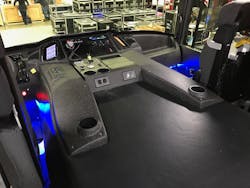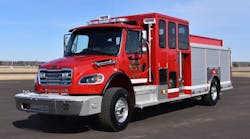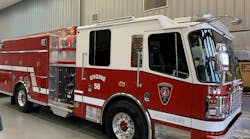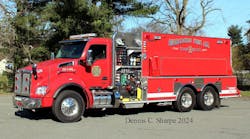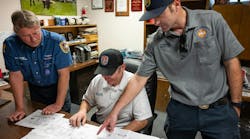As technology continues to settle into all aspects of daily life, it’s no wonder there’s more and more whiz-bang “stuff” found on fire apparatus.
Once thought of as strictly utilitarian work trucks, fire apparatus are now incorporating the technology of high-end luxury autos, and some are as fancy as the latest model privately owned pickup trucks found in the parking lots of fire stations.
And there has been some prototype work done on self-driving apparatus, although no one is really sure if that technology is ready for prime time in the fire service.
To get a sense of the extent of automotive-type technology making its way into fire apparatus, Firehouse spoke with a few manufacturers to get their take on the trend.
“Ultimately, as technology advances and younger generations are introduced to the fire service, you will start to see industry design be more reflective of their wants and needs,” said Todd Ernst, director of marketing and communication for HME Ahrens-Fox, an apparatus builder in Wyoming, MI.
Cup holders, USB power outlets, power seats and power windows are becoming more prevalent in fire apparatus, said Scott Weishaar, the executive director of product management for Spartan Emergency Response, an apparatus builder headquartered in Charlotte, MI.
“The fire industry has rapidly adapted and introduced comfort details and aspects of the truck, such as outstanding A/C or heaters, seating comfort and visibility, seat occupancy and seat belt-fastener alerts and airbags,” Weishaar added.
Backup Cameras
Backup cameras are nearly standard features on new autos today, and Brett Jensen—vice president and general manager of Midwest Fire, an apparatus builder in Luverne, MN—said the trend is expanding into the fire apparatus market as well.
“We’re seeing more and more of them every day,” Jensen said. “I am surprised it’s not an NFPA (National Fire Protection Association) standard.”
Jensen shared that backup cameras, side-view cameras and even some “bird’s eye view” camera systems are commonplace these days.
“They are very inexpensive and almost a requirement for apparatus,” he said, noting that a commercially made cab and chassis from Ford, Dodge or similar manufacturers often have the screens built into the dashboard. The apparatus manufacturer simply plugs the hardware into the chassis suppliers’ electrical harness and mounts the camera to the body, Jensen added.
Manufacturers reported that information and touchscreens in apparatus are not brand new, but they are being incorporated into more apparatus than ever before. In fact, touchscreen technology is standard on signature Ahrens-Fox product offerings, Ernst said.
Weishaar said Spartan has also been using color screens and user interface screens as its standard for the past 15 years.
Jensen said most manufacturers have followed the path into multiplex technology, which uses touchscreens to control equipment on apparatus.
“Most manufacturers are heavy into multiplexing, with touchscreens and push buttons,” Jensen said. “You’re going to see more and more of them.”
Cost Considerations
Sometimes, options are governed by price, Jensen said. Midwest Fire caters to small, rural, cost-conscious fire departments, he said, adding that departments covering communities with 500 people or less can’t afford the “bells and whistles” options. When a two-door commercial cab and chassis is the platform for the apparatus, the options are often limited as a matter of cost savings. Power windows for four-door apparatus is almost a must, he said, allowing for a bit of the bling.
Bill Doebler, vice president of sales for HME Ahrens-Fox, said HME has seen significant upticks in orders for power windows as well as power door locks as fire departments recognize the options as more than just conveniences.
To a tee, all manufacturers agree that some items once considered high-tech options, like stability control, rollover protection systems and occupant restraints, are now standard safety items.
“Our focus has been and remains on safety,” Weishaar said. “… As driving, handling and safety technologies advance, we will be rapidly validating and integrating [them] into our apparatus.”
Among the new technologies being validated currently are collision avoidance systems like those found on passenger vehicles and splashed all over TV ads for the latest model year.
Manufacturers were coy on what is in store for the future regarding that technology, but at least two acknowledged it is on the horizon.
“There’s a great deal of work taking place on this,” Weishaar said.
And Doebler said, “HME Ahrens-Fox is in the process of working on leapfrog technology in this area that will be brought to market in the near future.”
Self-Driving Vehicles
What might be in the future someday, but not in the immediate future, is self-driving technology for fire apparatus.
“Boy, it’s difficult to say never,” Weishaar said. “But our industry is so different than delivery vehicles or over-the-road trucks. I do not believe we will see self-driving apparatus in my lifetime. There are too many variables that require the skill and expertise of the engineer. I do not see artificial intelligence getting to that level of sophistication in the near future.”
Jensen, from Midwest Fire, agreed.
The technology has been demonstrated at shows and exhibitions, but when it comes to incorporating that level of artificial intelligence (AI) into tankers, pumpers and similar apparatus, “I don’t see that any time soon,” Jensen said.
Jensen did say, however, that the technology might be good for off-road vehicles that can be remotely controlled. He said there would be a cost to that kind of technology, but it is possible.
“You might see more of that all the time,” Jensen said.
And when it comes to the evolution of technology in our everyday lives, Ernst, from Ahrens-Fox, said we need not look much further than what most of us carry around in our pockets for a reality check.
“It’s easy to forget that just over a decade ago, the iPhone was introduced,” Ernst said. “And it’s just as hard to imagine not having such a device at our fingertips. I often joke, who would have imagined when Samuel Morse invented Morse Code in the 1830s, that the most important style of communication almost 150 years later, texting, is not much more than a digital variation of as much.”
